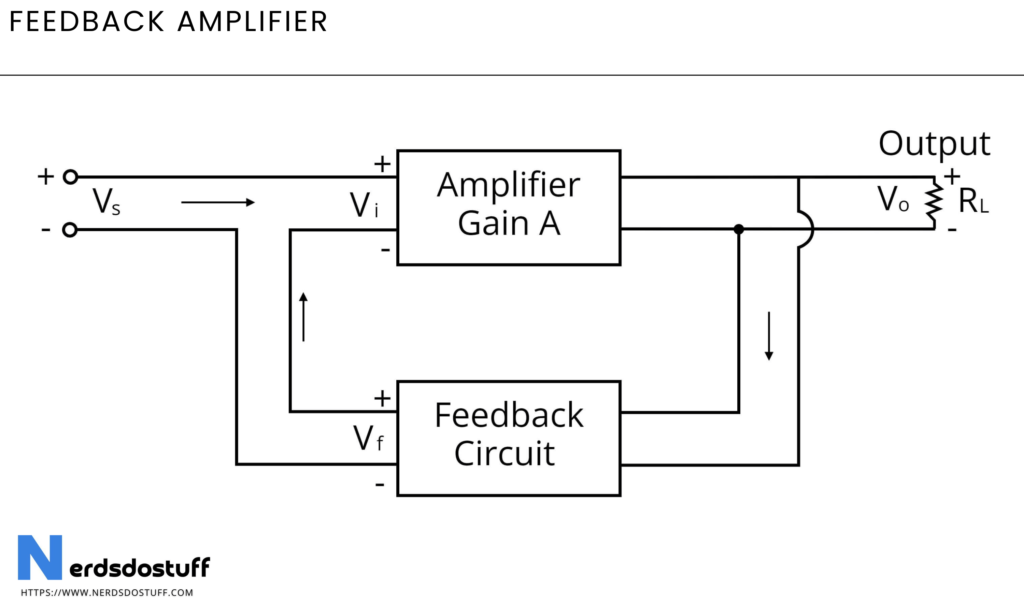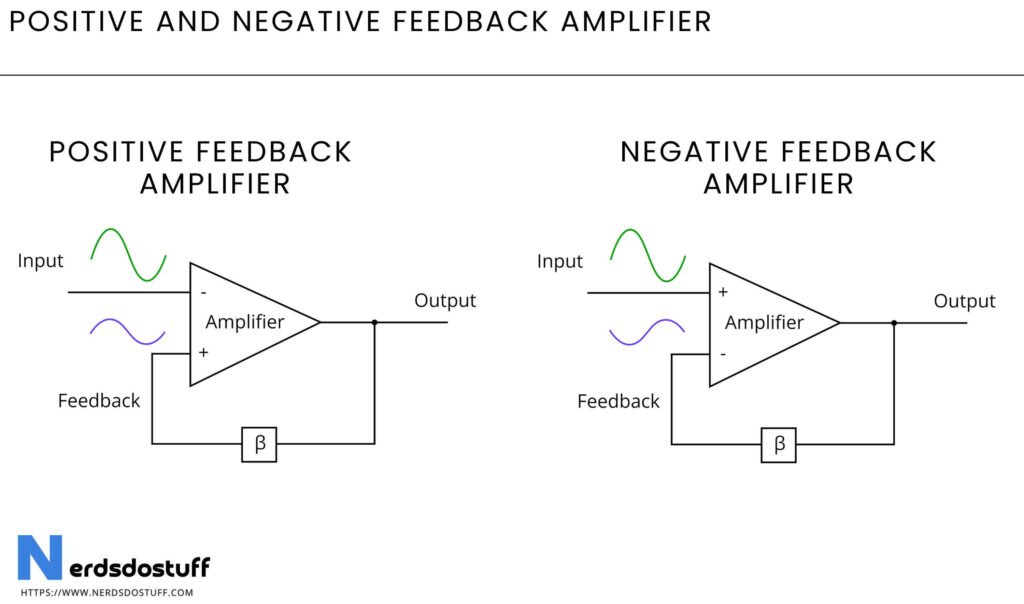What is Feedback Amplifier ?
A feedback amplifier is an electronic circuit that utilizes a portion of its output signal to be fed back to the input in order to control and improve its performance. The feedback loop allows for the adjustment of gain, bandwidth, distortion, and other characteristics, contributing to stability and precision. There are two main types of feedback in amplifiers: negative feedback, where the phase of the feedback signal opposes the input signal, reducing distortion and enhancing linearity; and positive feedback, which can increase gain but may lead to instability if not carefully controlled. Feedback amplifiers play a crucial role in various electronic applications, from audio amplifiers to communication systems, by striking a balance between performance and stability through the regulated interaction of input and output signals.
Types of Feedback Amplifier
Feedback amplifiers can be categorized into two main types based on the nature of the feedback: positive feedback and negative feedback. Each type has its own characteristics and applications.
1. Negative Feedback Amplifiers:
a. Voltage Series Feedback:
- The feedback is taken from the output voltage and applied in series with the input voltage.
- Commonly used in voltage amplifiers.
b. Voltage Shunt Feedback:
- The feedback is taken from the output voltage and applied in parallel (shunt) with the input voltage.
- Often used in operational amplifiers and other applications.
c. Current Series Feedback:
- The feedback is taken from the output current and applied in series with the input current.
- Found in current amplifiers.
d. Current Shunt Feedback:
- The feedback is taken from the output current and applied in parallel (shunt) with the input current.
- Used in current amplifiers.
2. Positive Feedback Amplifiers:
a. Voltage Series Feedback (Regenerative Feedback):
- The feedback is applied in series with the input voltage, reinforcing the input signal.
- Less common due to its tendency to cause instability.
b. Voltage Shunt Feedback (Regenerative Feedback):
- The feedback is applied in parallel (shunt) with the input voltage, reinforcing the input signal.
- Can be used in certain oscillators.
c. Current Series Feedback (Degenerative Feedback):
- The feedback is applied in series with the input current, opposing the input signal.
- Rare due to its potential to destabilize the amplifier.
d. Current Shunt Feedback (Degenerative Feedback):
- The feedback is applied in parallel (shunt) with the input current, opposing the input signal.
- Used in specific applications where controlled degeneration is required.
Why Feedback Amplifier is used ?
A feedback amplifier is used to improve the performance and characteristics of an electronic circuit or system. The primary purpose of incorporating feedback in amplifiers is to achieve desirable features such as increased bandwidth, improved linearity, reduced distortion, enhanced stability, and controlled gain.
Here are some key reasons why feedback amplifiers are employed:
- Stability: Feedback helps in stabilizing the amplifier against variations in component values, temperature changes, and other environmental factors. It reduces the sensitivity of the amplifier to external conditions, making it more reliable.
- Increased Bandwidth: Feedback can be used to extend the bandwidth of an amplifier. By trading off some gain for increased bandwidth, feedback allows the amplifier to operate over a wider range of frequencies.
- Reduced Distortion: Feedback helps in minimizing harmonic distortion and nonlinearities in the amplifier, leading to a cleaner and more accurate output signal.
- Controlled Gain: Feedback allows for precise control of the gain of the amplifier. This is particularly important in applications where a consistent and controlled amplification factor is required.
- Improved Linearity: Linearity refers to how well an amplifier preserves the input-output relationship. Feedback can be employed to enhance the linearity of an amplifier, ensuring that the output faithfully reproduces the input signal.
- Lower Output Impedance: Feedback can be used to reduce the output impedance of the amplifier, making it better suited to drive loads with varying impedance characteristics.
- Noise Reduction: Feedback can help in reducing the impact of noise in the amplifier circuit, resulting in a cleaner and more accurate output signal.
Feedback Amplifier Diagram

Working of Feedback Amplifier
The working of a feedback amplifier involves the use of a portion of the output signal being fed back to the input of the amplifier. This feedback signal is compared with the original input signal, and the difference between them is used to adjust the amplifier’s performance. There are two main types of feedback: positive feedback and negative feedback.

Negative Feedback Amplifier:
- Input Signal: The input signal is applied to the amplifier.
- Amplification: The amplifier amplifies the input signal to produce an output signal.
- Feedback Network: A portion of the output signal is taken and fed back to the input through a feedback network.
- Comparison: The feedback signal is compared with the original input signal.
- Error Signal: The difference between the input signal and the feedback signal (error signal) is determined.
- Adjustment: The error signal is used to adjust the amplifier parameters, typically by modifying the gain or other characteristics.
- Improved Performance: With negative feedback, the amplifier’s performance is stabilized, distortion is reduced, and other desirable characteristics such as bandwidth and linearity can be improved.
Positive Feedback Amplifier:
Positive feedback is less common in amplifier circuits, as it tends to increase instability and can lead to oscillations. However, in certain applications, it is intentionally used.
- Input Signal: The input signal is applied to the amplifier.
- Amplification: The amplifier amplifies the input signal to produce an output signal.
- Feedback Network: A portion of the output signal is taken and fed back to the input through a feedback network.
- Reinforcement: The feedback signal reinforces the original input signal.
- Output Enhancement: The positive feedback enhances the output signal, often resulting in increased gain or other specific characteristics.
- Potential Instability: Positive feedback, if not carefully controlled, can lead to instability and oscillations in the amplifier circuit.
Applications of Feedback Amplifier
- Audio Amplifiers:
- Negative feedback is often employed in audio amplifiers to improve linearity, reduce harmonic distortion, and extend the bandwidth. This results in clearer and more faithful reproduction of audio signals.
- Operational Amplifiers (Op-Amps):
- Op-amps frequently use negative feedback to stabilize and control their performance. This is crucial in applications like instrumentation amplifiers, voltage regulators, and signal conditioning circuits.
- Communication Systems:
- Feedback amplifiers play a crucial role in communication systems, where stability and signal fidelity are essential. They are used in radio-frequency amplifiers, transmitters, and receivers to enhance performance and reduce distortion.
- Control Systems:
- Negative feedback is extensively used in control systems to regulate and stabilize dynamic processes. It is employed in servo amplifiers, motor control circuits, and other feedback control systems to improve accuracy and response time.
- Biomedical Instrumentation:
- In biomedical applications, feedback amplifiers are utilized in devices such as electrocardiogram (ECG) amplifiers and medical imaging equipment. Negative feedback helps ensure accurate and reliable signal amplification.
- Power Amplifiers:
- Both negative and positive feedback can be used in power amplifiers. Negative feedback improves linearity and reduces distortion in linear power amplifiers, while positive feedback is sometimes used in Class D amplifiers to increase efficiency.
FAQs
Q. What is feedback in amplifiers?
Feedback in amplifiers refers to the process of returning a portion of the output signal back to the input. This is done to modify or control the amplifier’s performance, influencing characteristics such as gain, stability, and distortion.
Q. What is the purpose of using negative feedback in amplifiers?
Negative feedback is used to stabilize amplifier circuits, reduce distortion, improve linearity, and control other performance parameters. It involves feeding back a portion of the output signal with an inverted phase to the input.
Q. How does positive feedback differ from negative feedback in amplifiers?
Positive feedback reinforces the original input signal, potentially leading to increased gain and distortion. Negative feedback, on the other hand, attenuates the input signal, improving stability, linearity, and reducing distortion.
Q. What are the advantages of feedback amplifiers?
Feedback amplifiers offer several advantages, including increased bandwidth, improved stability, reduced distortion, controlled gain, and enhanced linearity. These characteristics make them versatile and suitable for a wide range of applications.
Q. Are there any drawbacks to using feedback in amplifiers?
While feedback amplifiers provide numerous benefits, they can introduce challenges such as potential instability, phase shifts, and increased complexity. Careful design is required to balance the advantages and potential drawbacks of feedback.
Q. In which applications are feedback amplifiers commonly used?
Feedback amplifiers are commonly used in audio systems, communication devices, operational amplifiers, control systems, biomedical instruments, and power amplifiers. Their versatility makes them suitable for various electronic applications where performance control and improvement are essential.




